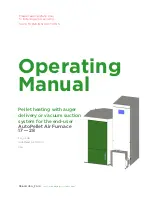
830CA: Installation, Start–Up, Operating and Service and Maintenance Instructions
Manufacturer reserves the right to change, at any time, specifications and designs without notice and without obligations.
22
Venting Notes for
1. For common vent, vent connector sizing and vent material: United
States-use the NFGC.
2. Immediately increase to 5-inch (127 mm) or 6-inch (152 mm) vent
connector outside furnace casing when 5-inch (127 mm) vent
connector is required, refer to Note 1 above.
3. Side outlet vent for upflow and downflow installations must use
Type B vent immediately after exiting the furnace, except when
factory-authorized, Downflow Vent Guard Kit, is used in the
downflow position. See Product Data for accessory listing.
4. Type-B vent where required, refer to Note 1 above.
5. Four-inch single-wall (26 ga. min.) vent must be used inside
furnace casing and when the Downflow Vent Guard Kit is used
external to the furnace. See Product Data for accessory listing.
6. Factory-authorized accessory Downflow Vent Guard Kit required
in downflow installations with lower vent configuration. See
Product Data for accessory listing.
7. Secure vent connector to furnace elbow with (2) corrosion-resistant
sheet metal screws, spaced approximately 180° apart.
8. Secure all other single wall vent connector joints with (3) corrosion
resistant screws spaced approximately 120° apart.
9. Secure Type-B vent connectors per vent connector manufacturer’s
recommendations.
START-UP, ADJUSTMENT, AND SAFETY
CHECK
General
1. Maintain 115-v wiring and ground. Improper polarity will result in
rapid flashing LED and no furnace operation.
2. Make thermostat wire connections at the 24-v terminal block on the
furnace control. Failure to make proper connections will result in
improper operation, see
.
3. Gas supply pressure to the furnace must be greater than 4.5-In.
W.C. (0.16 psig) but not exceed 14-In. W.C. (0.5 psig).
4. Check all manual-reset switches for continuity.
5. Install blower compartment door. Door must be in place to operate
furnace.
6. Replace outer door.
Start-Up Procedures
1. Purge gas lines after all connections have been made.
2. Check gas lines for leaks.
3. To Begin Component Self-Test:
Remove Blower Access Door. Disconnect the thermostat R lead
from furnace control board. Manually close blower door switch.
Turn Setup DIP switch SW1-6 ON, see
and
.
NOTE:
The furnace control allows all components, except the gas
valve, to be run for short period of time. This feature helps diagnose a
system problem in case of a component failure. Component test feature
will not operate if any thermostat signal is present at the control.
Refer to service label attached to furnace or see
.
Component test sequence is as follows:
a. Inducer motor turns on at 50% duty cycle for 15 secs, then stays
on for the entire test.
b. Hot surface igniter is energized for 15 sec., then off.
c. Blower motor operates for 15 sec.
d. After component test is completed, one or more status codes (11,
25, 41 or 42) will flash. See component test section of service
label ((
) in furnace for explanation of status codes.
NOTE:
To repeat component test, turn setup switch SW1-6 OFF, then
back ON.
4. Turn setup DIP switch SW1-6 OFF. Reconnect R lead to furnace
control board, release blower door switch and reinstall blower
access door.
5. Operate furnace per instruction on inner door.
6. Verify furnace shut down by lowering thermostat setting below
room temperature.
7. Verify furnace restarts by raising thermostat setting above room
temperature.
Adjustments
WARNING
!
FIRE HAZARD
Failure to follow this warning could result in personal injury, death
and/or property damage.
This furnace is equipped with manual reset limit switches in the gas
control area. The switches open and shut off power to the gas valve if a
flame rollout or overheating condition occurs in the gas control area.
DO NOT bypass the switches. Correct inadequate combustion air
supply problem before resetting the switches.
CAUTION
!
CUT HAZARD
Failure to follow this caution may result in personal injury.
Sheet metal parts may have sharp edges or burrs. Use care and wear
appropriate protective clothing, safety glasses and gloves when
handling parts and servicing furnaces.
WARNING
!
FIRE AND EXPLOSION HAZARD
Failure to follow this warning could cause personal injury, death and/or
property damage.
Never test for gas leaks with an open flame. Use a commercially
available soap solution made specifically for the detection of leaks to
check all connections. A fire or explosion may result causing property
damage, personal injury or loss of life.
WARNING
!
FIRE HAZARD
Failure to follow this warning could result in injury, death and/or
property damage.
DO NOT bottom out gas valve regulator adjusting screw. This can
result in unregulated gas valve outlet pressure and result in excess
overfire and heat exchanger failures.
CAUTION
!
FURNACE DAMAGE HAZARD
Failure to follow this caution may result in reduced furnace life.
DO NOT redrill orifices. Improper drilling (burrs, out-of-round holes,
etc.) can cause excessive burner noise and misdirection of inlet gas, See
















































